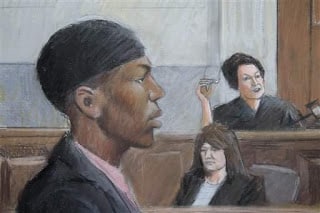- Witnesses, and possibly the accused, are the people who have seen or experienced the event in question.
- Their task is to answer the lawyers’ questions to the best of their abilities and provide testimony/evidence.
- They must answer clearly and truthfully so that the judge/jury can understand what really happened and make an informed decision.
Witnesses:
- Witnesses have an impact on a case from the minute they are called to the Witness stand.
- Body Language: What a witness wears, how they wear their hair, how they walk, move, sit, how they speak, how loud or quiet they are, if they have an accent, what intonation or expressions they use, where they put their hands, where they look with their eyes can all have an
 impact on the message they are trying to send to the judge or jury.
impact on the message they are trying to send to the judge or jury. - Witnesses may be presented by both the Crown Attorney and Defence Counsel.
- Witnesses may then be placed into sub categories which identify the type of evidence they are going to present. (Examples: Eye Witnesses, Character Witnesses, Expert Witnesses)
Types of Evidence / Witnesses
- A trial presents information that proves or disproves the elements of an offence; subsequently proving or disproving the argument put forth by the Crown or Defence Attorney.
- Direct Evidence is when someone has witnessed the commission of the offence. Confessions constitute this form of evidence however the confession must be done in front of a legal official, e.g. a police officer or lawyer, and without any undue coercion. (The police can NOT beat a confession out of you) With a confession the police will often ensure that you have been notified of your rights (Silence, Lawyer) and they will ask you to repeat the confession either on a recording or in a written statement.
- Polygraphs are inadmissible in court as they are an imperfect technology that can be fooled and they only indicate a likelihood as to the validity of the answer.
- Circumstantial Evidence is when someone has witnessed events prior to or after the offence without directly seeing the act. (Example: You saw the individual with a package enter the building. Minutes later you heard an explosion come from the building. From your perspective, you saw the person who committed the crime but you didn’t actually see the act take place.)
- Similar Fact Evidence show the accused has committed similar offences in the past. (This may or may not be admissible in court depending on the nature of the crime.)
- Hearsay Evidence is evidence that someone other than the witness has said or written. It is generally not admissible. (Example: Timmy told me that he saw the guy go into the building with a package. No cross-examination of this evidence is necessary as the witness cannot testify as to its truth; no real evidence is being presented as it can not be proven.)
- Opinion Evidence what an expert thinks about facts and scientific evidence pertaining to a case. An Expert Witness has no bias as to the outcome of the case and is deemed to be more credible as they are often accredited, educated individuals.
- Character Evidenceindividuals, who have Personal knowledge about the accused, or a witness, may be called forward as a witness to speak on behalf of their good/poor character. (Such evidence can be labelled as circumstantial or even irrelevant because of the bias that may be involved. However, Character Witnesses can provide greater insight into the behaviour or mental state of an individual that others may not be aware of. Thus Character witnesses can be asked to speak in court if they can contribute something important to the outcome of the case.)
- Physical/Forensic evidence involves the scientific study of the crime scene, materials found at the scene or on the accused, by the SIU (Special Investigation Unit) Includes: Any Object, Impression or Body Element such as Blood, Fingerprints, Hair, Tissue, Semen, or DNA.
- Many other elements may be labelled as physical evidence such as clothing, furniture, and other worldly possessions. Ballistics, GSR, Knife wounds etc also constitute this form of evidence. Photos, taken after the fact, are allowed only to give accurate representation of a crime scene. Video/Audio tapes are admissible if the person had no reasonable expectation of privacy; or surveillance, such as wiretapping, was authorized by officials who followed proper procedures
- In order for physical evidence to be admissible in court procedure dictates that there must be a clear chain of custody. Chain of Custody: The witnessed, written record, detailing: dates, times, and circumstances of evidence handling by all of the people who had control over items of evidence.
- Voir Dire is a trial within a trial to see if evidence can be shown to the jury. The Judge asks jury to leave courtroom and listens to Crown and defence positions on the matter. The Judge then makes a decision based on rules of evidence to determine if the evidence is admissible. The Jury then returns and trial continue.
- The Accused is innocent until proven guilty. The Accused can not be forced to take the stand in their own defence as they can not be made to incriminate themselves. (However choosing not to take the stand may be detrimental to the Defences case as it may influence the jury…not that its supposed to!)
